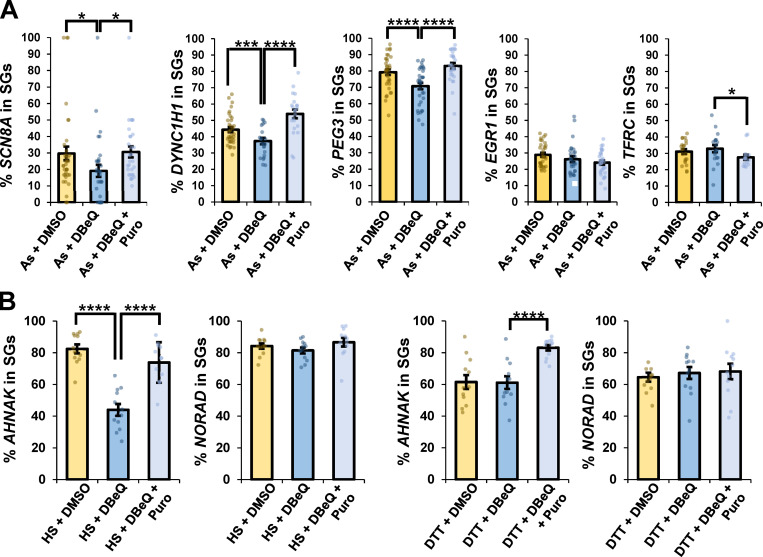Figure 3.
VCP inhibition affects the targeting of specific transcripts to SGs during arsenite stress, and VCP is required for complete AHNAK localization to SGs upon heat stress, but not ER stress. (A) U-2 OS cells were stressed with arsenite (As; 0.5 mM) in the presence or absence of DMSO (0.1%), DBeQ (10 µM), or DBeQ (10 µM) plus puromycin (Puro; 10 µg/ml) for 45 min. Cells were fixed, smFISH was performed, and cells were imaged at 100× on a DeltaVision microscope. The average percent SCN8A (As + DMSO n = 36 cells; As + DBeQ n = 32 cells; As + DBeQ + Puro n = 30 cells), DYNC1H1 (As + DMSO n = 34 cells; As + DBeQ n = 23 cells; As + DBeQ + Puro n = 22 cells), PEG3 (As + DMSO n = 34 cells; As + DBeQ n = 34 cells; As + DBeQ + Puro n = 28 cells), EGR1 (As + DMSO n = 33 cells; As + DBeQ n = 28 cells; As + DBeQ + Puro n = 32 cells), and TFRC (As + DMSO n = 22 cells; As + DBeQ n = 19 cells; As + DBeQ + Puro n = 15 cells) mRNAs in SGs ± SEM are shown, with *, P ≤ 0.05; ***, P ≤ 0.005; and ****, P ≤ 0.001. (B) U-2 OS cells were subjected to heat stress (HS; 42°C for 45 min) or DTT (2 mM for 45 min) and processed as in A. For all DTT and HS conditions, AHNAK and NORAD n = 12 cells. The average percent AHNAK or NORAD RNAs in SGs ± SEM from maximum intensity projections of 25 z-stacks is shown, with individual points representing a single cell from two independent replicates. Student’s t test was done to assess significance, with ****, P ≤ 0.001. Exact P values and source data are provided in Table S1.

